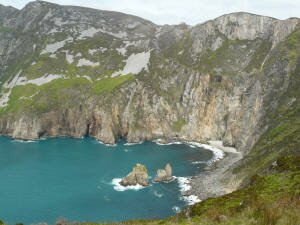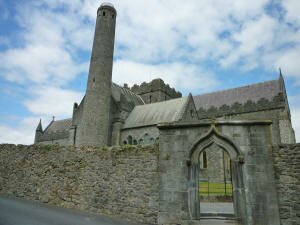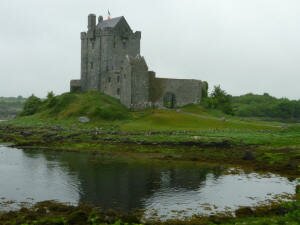June 1 – 16th
Ireland
When last we posted we indicated that we nearly had Internet meltdown. So what happened is that our nifty mobile broadband modem/router stopped working once we crossed the border from Northern Ireland into the Republic of Ireland. We were under the mistaken idea that our 3 Network worked throughout the region, but as we rudely found out, coverage stopped at the border.
Luckily, where we stopped at the first town in Ireland, we found a café with free wifi. After first unsuccessfully trying to find someone to unlock our modem, we were able to do some research and successfully got our modem unlocked from the UK network. Next stop, a new wireless store where we tested a new SIM card – yes it works, and topped up our account so that we could stay online throughout the country.
As it turned out, we stayed with the 3 Network Ireland as they were in charge of bringing broadband internet to all of rural Ireland – and we found that we were able to get online just about everywhere in the country, even on a mountain top!
Neolithic burial cairns on a mountain top
%20(800x600)%20(2)_small.jpg)
|
|
The route we traveled around the island went basically counterclockwise from the northwest corner, down the west coast, across the bottom then up to Dublin where we caught a ferry across to Holyhead in Wales.
|
We explored Neolithic sites nearly 5,000 years old, traveled through areas hard hit by emigration during the potato famine and again during the economic troubles after WWII, and explored Ireland's World Heritage Sites. We even saw shipwrecks.
|
Many of the roads we traveled on, even the so-called main roads, were barely wide enough for the truck to fit in our lane. It took a while, but we did get used to the squeeze as we often had to pull to the side and stop while even larger vehicles passed by in the opposite direction.
| Signage was a challenge as intersections had so many signs it was often impossible to figure out where we were supposed to go. At these times we just crossed our fingers and relied on our GPS (SatNav) to take us in the right direction. |
Ireland benefited from a very strong economy – prior to the global slowdown. The Celtic Tiger, as it was called, benefited people across the country. We saw new homes being built just about everywhere. We did see many traditional homes, some with grass roofs that were held on with rocks, and many older ruins. This Tiger was helped along by low taxes. Unfortunately, the low taxes meant that most of the roads that we traveled on were in absolutely terrible condition. The only good roads were the new highways that were being built with financial help from the EU.
|
We suffered our first attack of the midges – tiny biting flies, similar to no-see-ums. Thankfully we only had the one attack – we understand that during the height of summer, the midges can be merciless. We also saw lots of different types of birds, here's one of the friendly robins. |
Ireland has a wealth of historical sites that date back as far as 4000BC. We visited many of the so-called Neolithic cemeteries where we explored Dolmans, standing stones and rock covered burial cairns. We find these rock tombs and stone sites to be remarkable. Some of these cap stones weight several tons - so how did they move them?
|
We visited a musical festival held at a local school where all the contestants were school kids, and they were great. Traditional Irish music is very much a part of the way of life. Whether the people play the tin whistle (flute), the drums, fiddle or banjo, drum or bodhran (boh-Rawn) which is a goatskin hand drum beaten with a double-ended stick, or the accordion. Kids are taught in school, there are contests throughout the year, trad (traditional) music can be heard in pubs across the country. We attended trad sessions whenever we were in a village overnight. |
In several towns our timing was just off by a few days to witness other exciting local events – in Donegal we missed the pig races and in Dingle we were too early for the horse racing on the beach.
In the south, we braved the Tourist Routes to explore the Ring of Kerry and the Slea Head Drive. Fabulous ocean views with cliffs dropping off below the skinny roads.

|
|
Some other interesting sites were the ruins of old churches, abbeys and monasteries as well as castles and fortified homes. Some of the churches dated back to the time when Christianity arrived in Ireland – back to the 6th century. Though these places were only ruins, the history was interesting and the grounds were fascinating to explore. At some point, the locals decided that since the ruins were hallowed grounds, they would be great places to be buried. So the grounds were full of graves, crosses and stones – some were recent, many dated back hundreds of years.
In Glenveagh National Park, we visited botanical gardens that were bursting with colors as rhododendron, poppy, lupine and hundreds of other flowering plants were in bloom.
As we traveled further south, the land was more fertile, so there was more wealth for the landowner. This translated to more and more castles and fortified homes the further south we traveled. Even though we were spotting these places in nearly every village, we still stopped to look. After taking dozens of photos we got to the point of looking but not taking photos.
One week picked up a gnome or some other uninvited ghost. What? Well we began to suffer unexplained electrical issues in unrelated equipment. First our cab stereo wouldn’t work, then it was Don’s computer that wouldn't turn on, then one of our fans didn’t work, then our house stereo turned itself on during the middle of the night. Totally weird things, and fortunately they only lasted for short periods of time. We still don’t know what happened.
We consistently found really nice wild spots to camp, some along the water, some in the mountains and some even in towns and cities.
| Our interactions with the Irish people were all great. People were friendly, helpful and curious. There was the fellow who was a Bob Seger fan and wanted to know if we were too. Then there was the fisherman who we talked to who was loading his catch onto the transport truck – who gave us two very large, very much alive Irish crabs to cook up. That was a challenge, but we figured out how to cook them and had fresh crab for breakfast. Ooh yeah. |
| And then as we tried to drive across Dublin, after successfully driving into the city, parking and visiting the Archeological Museum, - our GPS (SatNav) failed to show us any streets in the City. Even using our maps we still got hopelessly lost in the warren of one-way streets and bus only lanes. Eventually we talked a taxi into leading us out of the downtown center and to the ferry port. What a way to end our visit! |
|
Home UK Journal |
%20(600x800)%20(2)_small.jpg)
_small.jpg)
_small.jpg)
_small.jpg)
_small.jpg)
_small.jpg)
_small.jpg)
_small.jpg)
_small.jpg)
_small.jpg)
_small.jpg)
_small.jpg)
_small.jpg)
%20(800x600)%20(2)_small.jpg)
%20(800x600)%20(2)_small.jpg)
_small.jpg)
_small.jpg)
_small.jpg)

_small.jpg)
_small.jpg)

_small.jpg)
_small.jpg)
%20(2)_small.jpg)
_small.jpg)
%20(800x600)%20(2)_small.jpg)
_small.jpg)
%20(800x600)%20(2)_small.jpg)
%20(600x800)_small.jpg)
%20(800x600)_small.jpg)
%20(800x600)%20(2)_small.jpg)
%20(800x600)%20(2)_small.jpg)

_small.jpg)
%20(800x600)%20(2)_small.jpg)
%20(800x600)%20(2)_small.jpg)
%20(800x600)%20(2)_small.jpg)
_small.jpg)